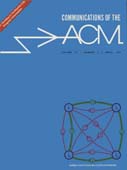April 1970 - Vol. 13 No. 4

Features
Creation and control of internal data bases under a Fortran programming environment
A method is described for the definition of a user's COMMON structure and the automatic generation of the necessary COMMON, DIMENSION, EQUIVALENCE, and type declarations for each of the user's routines. The definition for the COMMON is contained in an easy to modify form, thus allowing the control of general communications of data between routines. The described system has been implemented on the IBM 7094, CDC 6000 series, and the IBM 360. The method has proved to be invaluable for the definition and control of COMMON in many large-scale programs.
Syntax-directed documentation for PL360
The language PL360, together with its phrase structure grammar, is used as a concrete basis for illustrating an idea called syntax-directed documentation. This idea is: (1) to use the phrase structure of a program to define the structure of a formal documentation for that program; (2) to use the syntactic types and identifiers in the resulting structure to trigger the automatic formation of questions to the programmer, whose answers will become part of that documentation; and (3) to provide automatic storage and retrieval facilities so that other programmers who want to understand or modify the program can access the resulting documentation, which is cross-indexed in various ways by syntactic types and objects. A small PL360 program, already found in the literature, is worked out as an example.
Some complete calculi for matrices
A matrix calculus is introduced with the intention of developing data structures suitable for a high level algorithmic language for mathematical programming. The paper investigates how the special structure of matrices can be described and utilized for efficient computing by saving memory space and superfluous operations.
Sequences of matrices (and sequences of sequences of matrices) are considered, and matrix operators are extended to sequence operators and cumulative operators.
Algorithms are given which use symbol manipulation of matrix expressions so as to find the forms best suited for computation. These forms are called normal forms. Several completeness results are obtained in the sense that for each expression an equivalent expression in normal form can be found within a specified calculus.
The nucleus of a multiprogramming system
This paper describes the philosophy and structure of a multi-programming system that can be extended with a hierarchy of operating systems to suit diverse requirements of program scheduling and resource allocation. The system nucleus simulates an environment in which program execution and input/output are handled uniformly as parallel, cooperating processes. A fundamental set of primitives allows the dynamic creation and control of a hierarchy of processes as well as the communication among them.
Representations for space planning
Problems involving the arrangement of objects in two- or three-space where the objective function primarily consists of derivatives of the distance between objects or their arrangement are called space planning problems. The representational requirements for this problem area are defined and compared with current computer graphic languages. Four alternative data structures that allow automated space planning are described and compared.
The problem of the cyclical majority is presented and some new, simulated results for 3, 4, 5, … , 40 issues and 3, 5, 7, … , 37 judges are reported.
Cubic splines on uniform meshes
A very simple procedure is presented for constructing cubic splines, periodic or nonperiodic, on uniform meshes. Arcs of two cubics suffice to construct a basis of cardinal splines. An algorithm is given which requires only minimal storage and computation and permits easy trade-off of one against the other.
Comment on multiprogramming under a page on demand strategy
It has been brought to my attention that Figure 5 in my paper [1] is not consistent with Figure 2 in the paper [2], as it was meant to be. In the former the ordinate is defined as the incremental number of instructions executed between page demands, but the curve corresponds to the cumulative measure given in the latter.
Comment on Lawler’s multilevel Boolean minimization
Lawler [1] proposed a method of multilevel Boolean minimization which is a generalization of the conventional prime implicant approach for two-level minimization. In his article, he presented two lemmas (Lemmas 1 and 2) that are important in reducing the number of calculations involved in obtaining a solution. These lemmas can be extended to increase the efficiency even more. In particular, it is possible to lower the upper limit of the function interval for an incompletely specified function [2]. Later, the extended version of these lemmas will be shown to be of value in several aspects of the minimization procedure.



